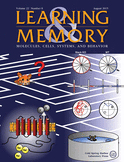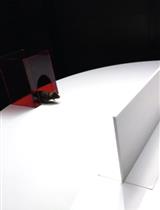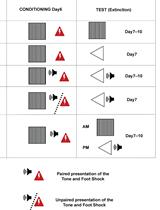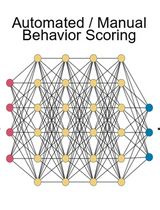- EN - English
- CN - 中文
Social Recognition Memory Test in Rodents
啮齿动物社会认知记忆测试
发布: 2016年05月05日第6卷第9期 DOI: 10.21769/BioProtoc.1804 浏览次数: 16044
评审: Soyun KimTifany DesprezPascal Fossat
Abstract
Social recognition memory is essential for the establishment and maintenance of a rodent colony. Recognition memory is important for social hierarchy, mate and offspring recognition, and interspecies recognition. Interspecies recognition is vital for recognizing frequent visitors to the animal’s habitat and whether or not the visitors pose a threat to the animals or colony (Macbeth et al., 2009; Noack et al., 2010). Here, we describe a protocol which effectively and reproducibly measures the social recognition for a juvenile male, a female, a mouse of another strain, and a rat. This task relies on the animal’s innate tendency to explore a novel social partner and decrease the exploration of a known familiar social partner (Thor et al., 1982). A significant decrease in the exploration of a partner from the training session to the recall session demonstrates a memory of the social partner. Also, we describe a social recognition procedure, the habituation-dishabituation paradigm that closely mimics typical short, frequent interactions between animals in a colony (Dantzer et al., 1987; Winslow and Camacho, 1995). Further, olfaction is a key component of social recognition, to test olfaction see Jacobs et al. (2016). In this protocol, we use transgenic NR2A overexpression mice to demonstrate how an impairment in social recognition memory may appear.
Background
Materials and Reagents
- Adult (3-8 months old) transgenic, knockout or treatment group mice (we use NR2A transgenic mice) and wild type mice (referred to as “subject mouse”)
- Juvenile (approximately 6-week old) male mice on the same genetic background
- Juvenile male mice on a different genetic background of a different color
- Approximately 3-month old adult female mice on the same genetic background
- Juvenile male rats
- 70% ethanol solution
Equipment
- Clean mouse cage identical to the home cage (standard mouse cage dimensions are 11 in x 7.5 in x 5 in), one for each subject mouse tested, change between sessions
- Clean rat home cage (standard rat housing cage dimensions are 22 in x 12.5 in x 8 in), one for each subject rat tested, change between sessions
- Clear Plexiglas to cover the cage top
- Small wire enclosure (for a female mouse), small wire pencil cup can be used (see Figure 1)
- Large wire mesh enclosure (for a juvenile male rat), made in-house from Plexiglas and wire mesh (Thermo Fisher Scientific, catalog number: AA42777HZ ) (see Figure 2)
- Digital recording camera
- Laboratory timer
- Stopwatch for recording investigation times
Procedure
文章信息
版权信息
© 2016 The Authors; exclusive licensee Bio-protocol LLC.
如何引用
Jacobs, S. A., Huang, F., Tsien, J. Z. and Wei, W. (2016). Social Recognition Memory Test in Rodents. Bio-protocol 6(9): e1804. DOI: 10.21769/BioProtoc.1804.
分类
神经科学 > 行为神经科学 > 学习和记忆
Share
Bluesky
X
Copy link












